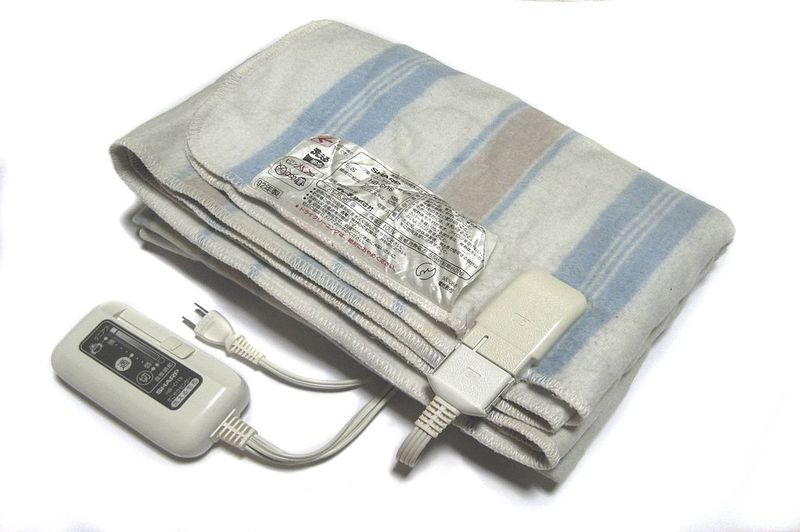Do you find wintry nights intolerable? You can read this tutorial to learn how to make an electric blanket at home.

This way, you can save your hard-earned money just on the heater and a warm bed.
Cranking up the thermostat to warm the whole apartment on a single night can be expensive, especially if you live alone.
Why would you waste money if you can make an electric blanket on your own?
This tutorial is so easy to make it will only take an hour to finish.
Materials Needed
- For the wire, you will need 6 feet of thin, flexible wire. However, make sure that it’s not so thin to the point of breaking easily once you twist and wrinkle the blanket.
- Carbon tape (20 mm, 20 ft)
- Conductive wire glue (silver
- Female plug (5.5 mm)
- If you’re in a hurry and have no time for needles and sewing, a no-sew hem tape (iron-on) can do the trick merely in seconds.
If you’re a beginner, you can still try doing the project if you carefully follow the instructions.
Be sure not to leave any bare wire lest you electrocute yourself.
In the presence of unwanted sparks, discontinue the project and apply safety measures first.
Guide On How To Make An Electric Blanket
Step #1. Prepare the fabric
Cut the fabric at a length of about 150 cm (5 ft.). Proceed to place the carbon tape in a zigzag fashion.
Prepare the hemming web tape and gently press the iron after placing the web tape under the carbon tape.
Step #2. Glue the wire
Using conductive wire glue, secure the wire to the carbon tape. Draw out the silver from the syringe by squeezing the carbon tape together.
At the opening, insert the wire and wait until the glue is dry.
Step #3. Fold the edges
Across the wire, put strips of hem tape. Fold the edges inward and iron gently on top.
Step #4. Lay the fabric on top
Get the other piece of fabric you saved earlier. Trace along the edges and put strips of hem tape.
Place the fabric on top and gently iron at the strips of tape.
Step #5. Have a power supply
Add the plug to your blanket then look for a power supply. A device, such as a laptop, is a good power supply, but sockets are fine.
Although for sockets, your bed needs to be near the wall.
Step #6. Ready the blanket for use
If a power source takes more effort for you, consider a battery. On average, the blanket will consume about 40 watts.
This amount of electricity is enough for sleeping in bed or sleeping bags.
Step #7. Use the blanket
To make the blanket more effective, you can place it under a sheet or on top of a mattress. You can even stitch it inside a duvet cover.
If any of these doesn’t appeal to you, you can always use them as a regular blanket.
How do I control the temperature?
If the original warmth of the blanket isn’t good enough for you, consider buying an RF dimmer to have heating options and a way of adjusting the temperature.
Dimmers for LED lights work best, as they already have a turning knob (if there are no buttons), aside from being waterproof.
Only upgrade with an RF dimmer if the blanket heat is unsatisfactory.
Is there a voltage limit for the carbon tapes?
Directly drawing power from a house plug is a bad idea.
Even though carbon tape can withstand any amount of voltage, the appropriate voltage still depends.
For example, 120v is considered a high voltage and is only apt for floor heating.
For electric currents involving clothing, one should keep to low voltages.
For coats, heated gloves, and an electric blanket, the recommended voltage ranges as low as 12v and as high as 24v.
Look for a female plug to insert the power cord with.
How much carbon tape do I need?
The length of carbon tape will depend on the voltage.
Since the tape is placed in a zig-zag shape, the path of current will slow down the heat.
Increasing the length will decrease the temperature and vice versa.
In this case, the zig-zags are made of Vs. 12v passes through each V, at an estimated length of 1.5 meters.
This blanket needs an average of 5 Vs, so the total length is around 7.5 meters.
Of course, adding more V is entirely up to you. Doing so will make the current more powerful, so heat production becomes more efficient.
However, the downside is reduced battery time.
Conclusion
Knowing how to make an electric blanket with simple materials loitering around can save you so much money.
Plus, you no longer have to endure the nights suffering in the harsh cold, especially in winter.
Blankets keep the cold at bay and make staying inside at home cozy and comfortable.
